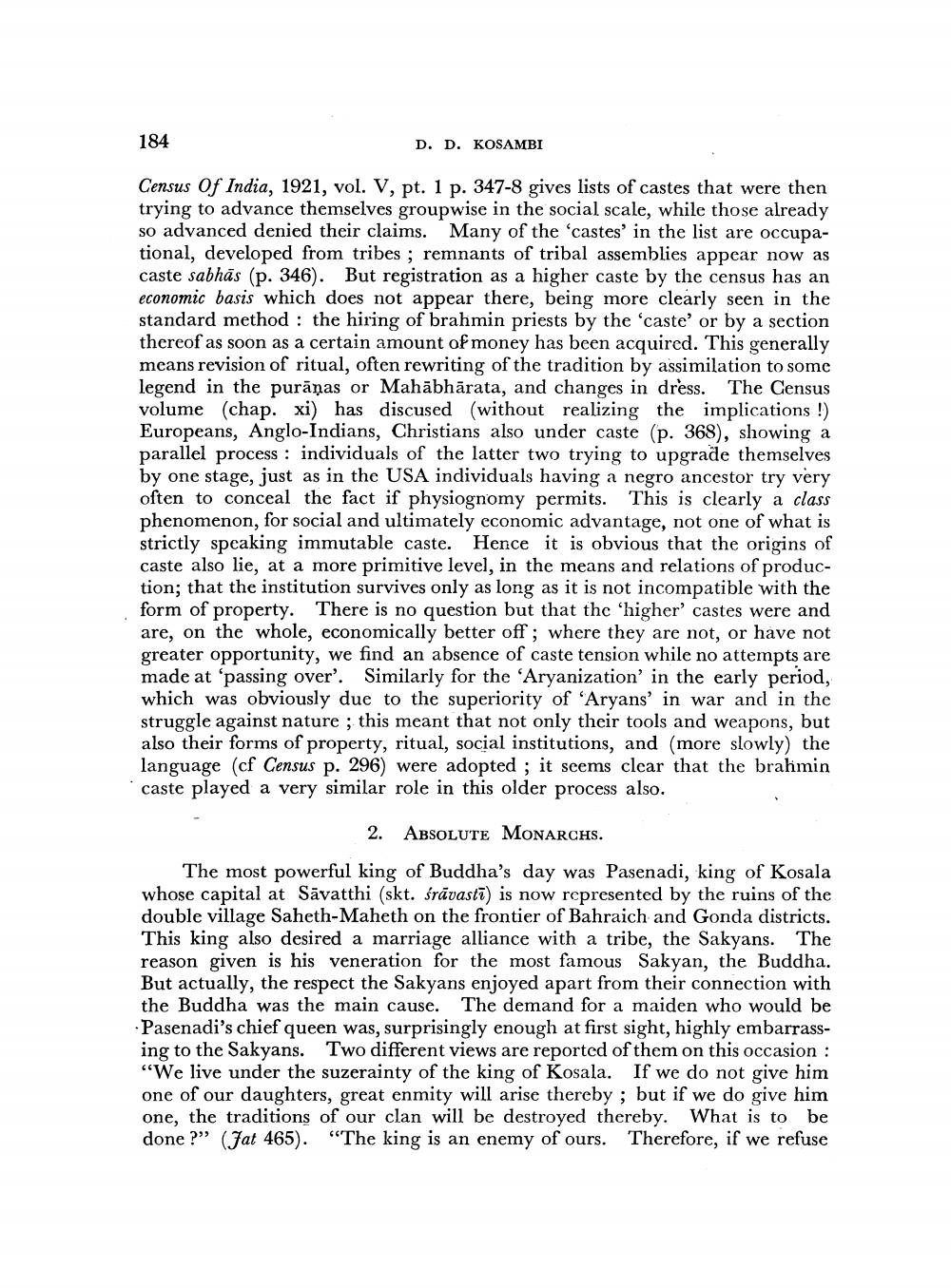Book Title: Ancient Kosala And Mmagadha Author(s): Dharmanand Kosambi Publisher: D D Kosambi View full book textPage 5
________________ 184 D. D. KOSAMBI Census Of India, 1921, vol. V, pt. 1 p. 347-8 gives lists of castes that were then trying to advance themselves groupwise in the social scale, while those already so advanced denied their claims. Many of the 'castes' in the list are occupational, developed from tribes ; remnants of tribal assemblies appear now as caste sabhās (p. 346). But registration as a higher caste by the census has an economic basis which does not appear there, being more clearly seen in the standard method : the hiring of brahmin priests by the 'caste' or by a section thereof as soon as a certain amount of money has been acquired. This generally means revision of ritual, often rewriting of the tradition by assimilation to some legend in the purāņas or Mahābhārata, and changes in dress. The Census volume (chap. xi) has discused (without realizing the implications !) Europeans, Anglo-Indians, Christians also under caste (p. 368), showing a parallel process : individuals of the latter two trying to upgrade themselves by one stage, just as in the USA individuals having a negro ancestor try very often to conceal the fact if physiognomy permits. This is clearly a class phenomenon, for social and ultimately cconomic advantage, not one of what is strictly speaking immutable caste. Hence it is obvious that the origins of caste also lie, at a more primitive level, in the means and relations of production; that the institution survives only as long as it is not incompatible with the form of property. There is no question but that the higher castes were and are, on the whole, economically better off; where they are not, or have not greater opportunity, we find an absence of caste tension while no attempts are made at 'passing over'. Similarly for the 'Aryanization' in the early period, which was obviously due to the superiority of 'Aryans' in war and in the struggle against nature; this meant that not only their tools and weapons, but also their forms of property, ritual, social institutions, and (more slowly) the language (cf Census p. 296) were adopted ; it seems clear that the brahmin caste played a very similar role in this older process also. 2. ABSOLUTE MONARCHS. The most powerful king of Buddha's day was Pasenadi, king of Kosala whose capital at Săvatthi (skt. śrāvastī) is now represented by the ruins of the double village Saheth-Maheth on the frontier of Bahraich and Gonda districts. This king also desired a marriage alliance with a tribe, the Sakyans. The reason given is his veneration for the most famous Sakyan, the Buddha. But actually, the respect the Sakyans enjoyed apart from their connection with the Buddha was the main cause. The demand for a maiden who would be Pasenadi's chief queen was, surprisingly enough at first sight, highly embarrassing to the Sakyans. Two different views are reported of them on this occasion : “We live under the suzerainty of the king of Kosala. If we do not give him one of our daughters, great enmity will arise thereby; but if we do give him one, the traditions of our clan will be destroyed thereby. What is to be done?” (Jat 465). "The king is an enemy of ours. Therefore, if we refusePage Navigation
1 ... 3 4 5 6 7 8 9 10 11 12 13 14 15 16 17 18 19 20 21 22 23 24 25 26 27 28 29 30 31 32 33 34
